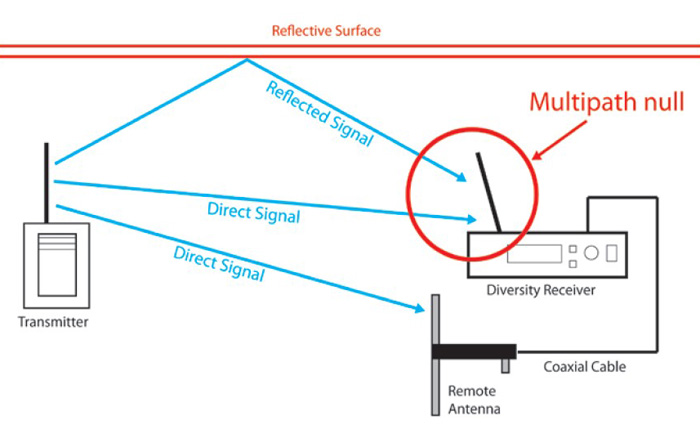
Securing antennas to the transmitter case and tying antennas to cables can be absolutely deadly to range. Skin can absorb RF energy, so it’s best to have the transmitter case and antenna away from the body.
Further, receiver antennas must extend away for the receiver case, as well as away from other antennas, equipment racks, other equipment, cabling and, again, metallic objects.
It’s best to mount receivers at the top of the rack so that the antennas extend above and away from the rack. Using rear-mounted antennas inside a metal rack will almost always result in poor reception.
For multiple receiver installations, the common practice of positioning front-mounted antennas in a “V” configuration, with all the antennas parallel, will also reduce range. It causes them to function together somewhat like a TV antenna that’s pointed upwards.
Even worse is when antennas from two different receivers touch. Not only will range be seriously compromised, interference becomes much more likely. In such a situation, it is much better to incorporate a single pair of antennas and then an antenna splitter to distribute the signals to the receivers in the rack.\\\
No obstructions. A clear path between the receiver and the transmitter is also required. This is sometimes called a “clear line-of-sight,” but remember, light will pass in a straight line through a small hole while radio waves will not.
Similar to the free space needed around an antenna, radio waves require a sizeable space in which to travel. The amount of space depends upon frequency; the lower the frequency, the more space needed. Create an imaginary tunnel of open air between the transmitter and receiver antennas. For UHF systems, a tunnel diameter of 3 feet or so is usually adequate.
There also should be no metallic objects – scaffolding, iron beams, cables, cabinets, pipes, etc. – within this space. In particular, large flat metal objects such as ducts, rows of cabinets and the like that are parallel to the path should be avoided. Even though they might not be in the direct path, they can still act similar to a mirror, reflecting RF energy away from the direct path.
Systems with diversity reception help avoid dropouts in these situations, but range can still be reduced. Diversity simply refers to the fact that for optimum reception, using two antennas in diverse locations is beneficial. The reason is that at times, there may be an RF null at the receiver caused by reflections of the transmitted signal off of metal objects or other surfaces.
To counter this, a second antenna in a different place will generally be receiving a slightly different version of the transmitter’s signal, and it is very unlikely that a null will happen on both antennas at the same time. But the key is that the two antennas are in slightly different spots, and this is one reason it’s often better to use remote antennas for your receiver rather than just the short whips that came with it.
Avoid long antenna cables. So sometimes it’s necessary or desirable to locate antennas at a farther distance from a receiver, and RF coaxial cables can be used to connect the antennas to the receiver inputs. However, there will be losses that can reduce operating range. The amount of loss depends upon the size, construction and quality of the cable, and upon the operating frequency.
Even high-quality cable will have a loss of about 8 dB per 100 feet at 200 MHz, and since every 6 dB of loss cuts range by half, the working range with 100 feet of this cable will be only 40 percent of normal at 200 MHz.
If long cable runs are a necessity, skimping on the cost of the highest quality cables available is a bad decision. For the best results, a premium foam-dielectric cable from a provider such as Belden should be used.
Don’t forget the transmitter batteries! Simple but true, and most certainly the number one cause of wireless problems the world over. Fortunately, it’s the one that’s easiest to fix.
Check transmitter batteries prior to every use. Get a battery tester to help determine a good battery from a bad one. And when in doubt, change to a new battery and/or keep those rechargables charged!

